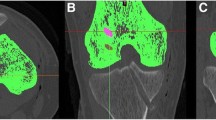Abstract
Purpose
For intra- and postoperative evaluation of precise and anatomic graft tunnel position, radiographs (XR) and computed tomography (CT) scans have been suggested. The purpose of this study was to evaluate the reliability and validity of XR and CT for quality assessment following PCL reconstruction.
Methods
Postoperative radiographs and CT scans were obtained in 45 consecutive patients following a standard single-bundle PCL reconstruction. Femoral and tibial tunnel apertures were correlated to femoral and tibial measurement grid systems. To assess the reliability and validity of XR and CT scans three independent observers evaluated radiographic and CT images for the position of femoral and tibial tunnel apertures.
Results
Almost perfect inter- and intra observer agreement (0.79–0.99) was found for all CT measurements except for the distance of the tunnel position to the previous physis line. Almost perfect and strong inter- and intraobserver agreement (0.70–0.98) was found for all tibial measurements on XR which tended to increase with repeated interpretation and to decrease with low levels of observer qualification. Femoral measurements yielded only poor-to-moderate reliability (0.02–0.5) between raters on XR but strong intraagreement within experienced observers (0.45–0.86). Specificity for XR was calculated with 75.7 % for P2 and P3 and with 71 % for femoral tunnel depth and height.
Conclusion
XR and CT represent complementary imaging modalities and both offer considerable accuracy and precision for the determination of femoral and tibial tunnel apertures following PCL reconstruction and can be recommended for intra- and postoperative quality assessment.

Similar content being viewed by others
References
Amis AA, Jakob RP (1998) Anterior cruciate ligament graft positioning, tensioning and twisting. Knee Surg Sports Traumatol Arthrosc 6:S2–S12
Bernard M, Hertel P, Hornung H, Cierpinski T (1997) Femoral insertion of the ACL: radiographic quadrant method. Am J Knee Surg 10:14–21
Chouteau J, Benareau I, Testa R, Fessy MH, Lerat JL, Moyen B (2008) Comparative study of knee anterior cruciate ligament reconstruction with or without fluoroscopic assistance: a prospective study of 73 cases. Arch Orthop Trauma Surg 128:945–950
Cooper DE, Stewart D (2004) Posterior cruciate ligament reconstruction using single-bundle patella tendon graft with tibial inlay fixation. Am J Sports Med 32:346–360
Doornberg J, Lindenhovius A, Kloen P, van Dijk CN, Zurakowski D, Ring D (2006) Two and three-dimensional computed tomography for the classification of distal humeral fractures. JBJS 88A:1795–1801
Galloway MT, Grood ES, Mehalik JN, Levy M, Saddler SC, Noyes FR (1996) Posterior cruciate ligament reconstruction. An in vitro study of femoral and tibial graft placement. Am J Sports Med 24:437–445
Greiner P, Magnussen RA, Lustig S, Demey G, Neyret P, Servien E (2011) Computed tomography evaluation of the femoral and tibial attachments of the posterior cruciate ligament in vitro. Knee Surg Sports Traumatol Arthrosc 19:1876–1883
Harness NG, Ring D, Zurakowski D, Harris GJ, Jupiter JB (2006) The influence of three-dimensional computed tomography reconstructions on the characterization and treatment of distal radius fractures. JBJS 88A:1315–1323
Johannsen AM, Anderson CJ, Wijdicks CA, Engebretsen L, LaPrade RF (2013) Radiographic landmarks for tunnel positioning in posterior cruciate ligament reconstructions. Am J Sports Med 41:35–42
Lorenz S, Elser F, Brucker PU, Obst T, Imhoff AB (2009) Radiological evaluation of the anterolateral and posteromedial bundle insertion sites of the posterior cruciate ligament. Knee Surg Sports Traumatol Arthrosc 17:683–690
Martin J, Marsh JL, Nepola JV, Dirschl DR, Hurwitz S, DeCoster TA (2000) Radiographic fracture assessment: which ones can we reliably make? J Orthop Trauma 14:379–385
McGuire DA, Hendricks SD (2010) Comparison of anatomic versus nonanatomic placement of femoral tunnels in Achilles double-bundle posterior cruciate ligament reconstruction. Arthroscopy 26:658–666
Meuffels DE, Potters JW, Koning AHJ, Brown CH, Verhaar JAN, Reijman M (2011) Visualization of postoperative anterior cruciate ligament reconstruction bone tunnels. Reliability of standard radiographs, CT scans and 3D virtual reality images. Acta Orthop 82:699–703
Moloney G, Araujo P, Rabuck S, Carey R, Rincon G, Zhang X, Harner C (2013) Use of a fluoroscopic overlay to assist arthroscopic anterior cruciate ligament reconstruction. Am J Sports Med 41:1794–1800
Osti M, Tschann P, Künzel KH, Benedetto KP (2012) Anatomic characteristics and radiographic references of the anterolateral and posteromedial bundles of the posterior cruciate ligament. Am J Sports Med 40:1558–1563
Parkar AP, Adriaensen MEAMP, Strand T, Inderhaug E, Harlem T, Solheim E (2013) How to read postoperative radiographs and CT scans after single-bundle anterior cruciate ligament reconstruction. Skeletal Radiol 42:1489–1500
Rosenberger RE, Bale RJ, Kneisl C, Krappinger D, Knoflach M, Attal R (2010) Two-dimensional fluoroscopic navigation in posterior cruciate ligament reconstruction: a preclinical cadaver study. Arch Orthop Trauma Surg 130:971–976
Silva A, Sampaio R, Pinto E (2012) ACL reconstruction: comparison between transtibial and anteromedial portal techniques. Knee Surg Sports Traumatol Arthrosc 20:896–903
Takahashi M, Matsubara T, Doi M, Suzuki D, Nagano A (2006) Anatomical study of the femoral and tibial insertions of the anterolateral and posteromedial bundles of human posterior cruciate ligament. Knee Surg Sports Traumatol Arthrosc 14:1055–1059
Tompkins M, Keller TC, Milewski MD, Gaskin CM, Brockmeier SF, Hart JM, Miller MD (2013) Anatomic femoral tunnels in posterior cruciate ligament reconstruction. Inside-out versus outside-in drilling. Am J Sports Med 41:43–50
Voos JE, Mauro CS, Wente T, Warren RF, Wickiewicz TL (2012) Posterior cruciate ligament. anatomy, biomechanics and outcomes. Am J Sports Med 41:222–231
Westermann RW, Sybrowsky C, Ramme AJ, Annunziato A, Wolf BR (2013) Three-dimensional characterization of the femoral footprint of the posterior cruciate ligament. Arthroscopy 29:1811–1816
Author information
Authors and Affiliations
Corresponding author
Rights and permissions
About this article
Cite this article
Osti, M., Krawinkel, A., Gohm, A. et al. The effectiveness of skeletal imaging for quality assessment in posterior cruciate ligament reconstruction: reliability and validity of radiographs and computed tomography. Arch Orthop Trauma Surg 134, 1731–1737 (2014). https://doi.org/10.1007/s00402-014-2084-7
Received:
Published:
Issue Date:
DOI: https://doi.org/10.1007/s00402-014-2084-7




